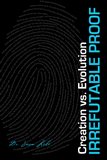Enter the Sea Dragon
Bizarre and Beautiful, Leafy Sea Dragons Inhabit an Unusual World Under the Ocean …
by Paula Weston on December 1, 1999Originally published in Creation 22, no 1 (December 1999): 54-55.
Bizarre and beautiful, leafy sea dragons inhabit an unusual world under the ocean.
They look like floating leaves and seaweed, use an air bladder to move up and down in the water, and the males give birth to the young.
So what are these amazing creatures?
They are known as sea dragons, spectacularly camouflaged marine creatures with some truly incredible design features. They are found only in coastal southern Australian waters and can be either “leafy” (looking like aquatic “leaves”) or “weedy” (resembling blades of brown seaweed).
The colour of sea horses and sea dragons is determined by the crustaceans they have been eating!
Due to their many similarities, sea dragons are classified, along with pipefish, in the same family as sea horses, i.e. Syngnathidae. (Greek: “together-jawed”.) This relates to their “tube-snouted” mouths.1
Adult sea dragons grow to about 45 cm (18 inches). They have no teeth or stomach, and feed on small shrimps. Making the most of their camouflage, sea dragons float seemingly harmlessly in the water, sucking unsuspecting passing prey into their mouths.
Sea dragons and sea horses also possess an internal air bladder, used for vertical motion. With little effort, they can rise or settle to another depth simply by changing the air volume within the bladder.2
But probably the most incredible feature shared by sea dragons and sea horses is the role played by the male in hatching the young. The female deposits as many as 250 eggs within a specialised area of soft skin beneath the male’s tail, known as a brooding pouch (or “patch”). These eggs are then fertilized by the male, and protected in a cup-like indentation for up to eight weeks before hatching.3
When the eggs are ready to hatch, the male contorts his body and expels the young through a single opening in the pouch.4 The fully-developed young hatch over a period of several days, dispersing over a wide area.
Encyclopædia Britannica notes that fossil sea horses (with which it appears to include sea dragons) are unknown, and there is only “limited paleontological [fossil] data” available to trace the (alleged) evolutionary history of the order to which they belong (Gasterosteiformes).5
Design is a far better explanation than random mutations and selection to explain the specialized features of the sea dragon such as its sensational camouflage, its air bladder, and the reproductive technique displayed in the sea dragon. The latter especially perplexes evolution-minded scientists, given the reproductive role reversal.
Of course, there is no mystery if we accept that the sea dragon did not evolve over millions of years, but is instead yet another example of the ingenious design of the Creator.
None
BrowseFootnotes
- In The Dragon’s Lair, <www.nexus.edu.au/schools/Kingscot/Pelican/seadragons/sd_menu.htm>.
- The New Encyclopædia Britannica, 15th Edition, 19:254, 1992.
- Underwater World Perth, <www.coralworld.com/perth/gallery/seadragons/>.
- The New Encyclopædia Britannica, 15th Edition, 10:579, 1992.
- The New Encyclopædia Britannica, 15th Edition, 19:255, 1992. [While the online Encyclopaedia Britannica (entry from 25 November 2004) still reads that “fossil sea horses are unknown”, there was one available online for purchasing at the time of this update. Fossilized sea horses may exist, but if so, are scarce. – Editor, 3 March 2006]
Recommended Resources
- © 2024 Answers in Genesis
- Privacy Policy
- Contact
- About



